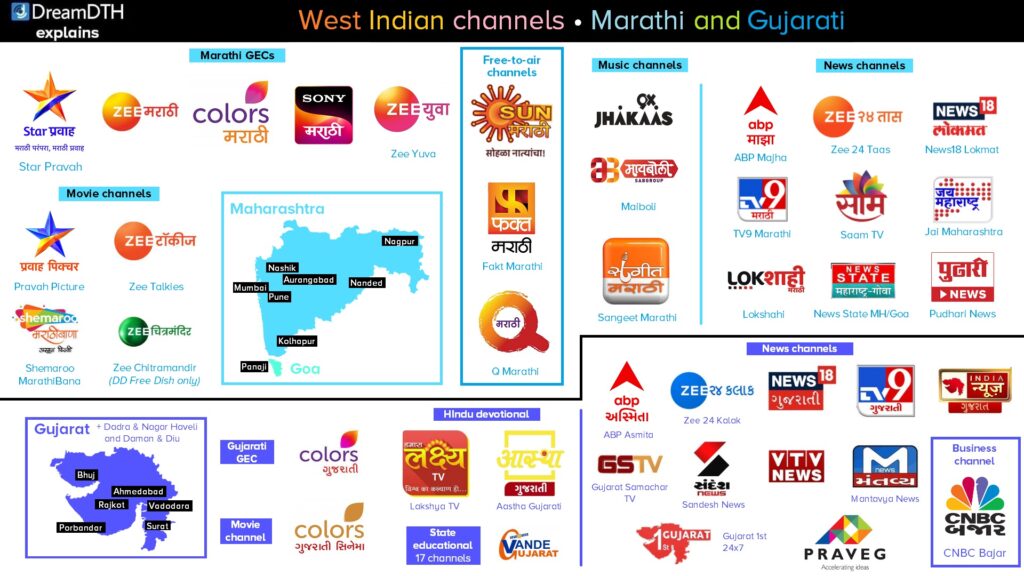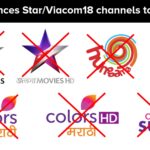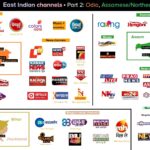Zee has focused heavily on Marathi, more than other languages — but lost to Star
One may be forgiven for not understanding why, despite having so many Marathi channels, Zee Marathi has been completely defeated at its own game by Star Pravah. Truth be told, it took Star Pravah over a decade to topple Zee Marathi from its perch on the pole position, as it had been the number one Marathi channel from 2011 to 2020, on the back of popular serials like Majha Navryachi Bayko and the paranormal horror/thriller show Ratris Khel Chale, and long-running reality shows like Chala Hawa Yeu Dya (stand-up comedy) and a local version of the singing show Sa Re Ga Ma Pa. This is quite unlike Star Jalsha, which has almost always been the leading Bengali channel ever since its launch in 2008, barring some brief periods in 2018–19 when Zee Bangla was the leader.
However, even though Star Pravah reached the top a decade after its Bengali sibling, it has increased its lead over Zee Marathi so much that it is out of sight for all other Marathi channels — much like sister channel Asianet in Kerala — and has reached the BARC national top 10 entirely on its own, whereas the gap between Star Jalsha and Zee Bangla (or Star Vijay and Zee Tamil, for that matter) is not that big. When even Zee Marathi has lost its glory, Colors Marathi and Sony Marathi are barely able to hold on to their BARC top-5 positions, and Sun Marathi — despite being free-to-air and available on DD Free Dish — has not been able to enter.
Zee’s preferential treatment of its Marathi channels is evident from the fact that it launched Zee Talkies all the way back in August 2007, its first regional-language movie channel and the only one until Zee Bangla Cinema became the second in 2012. It was only in the late 2010s and early 2020s that it launched other regional movie channels: Zee Cinemalu (Telugu) came in 2016, followed by Zee Biskope (Bhojpuri), Zee Thirai (Tamil) and Zee Picchar (Kannada) in 2019–20.
Zee Talkies also became Zee’s first regional channel in any genre to launch an HD feed, which it did on 15 October 2016 — a day before English GEC Zee Café’s rebrand, and exactly a year before the broadcaster’s mega-rebrand on 15 October 2017 which saw all Zee channels adopt a new logo scheme, and non-news channels shift their logos to the top left corner. On 20 November 2016, Zee Marathi and Zee Bangla also launched HD feeds, followed by its South Indian channels in 2017–18 — including Zee Keralam, which was newly launched in 2018.
More channels than any other language: Zee Yuva, Vajwa and Chitramandir
When other regional languages had only one GEC and one movie channel at most, Zee was busy planning for new Marathi channels. No sooner did it launch its secondary Marathi GEC Zee Yuva (named after youth) in August 2016 than it started its preparations to launch HD feeds for Zee Marathi and Zee Talkies, as described above — though Zee Yuva has not been very successful, and has lost its direction and focus. With the impending merger of Zee and Sony, there is a good chance that Zee might decide to give the moribund Zee Yuva the axe since there are too many Marathi channels (including Sony Marathi) as it stands. In October 2020, it went further with Zee Vajwa, a youth-oriented Marathi music channel — replacing Zee ETC Bollywood, an existing Hindi music channel — with a young, fresh and colourful graphics package, as shown below.
Moreover, after a few months in April 2021, it launched Zee Chitramandir exclusively for DD Free Dish — something that was completely unheard of, since all DDFD channels are supposed to be available on pay platforms as well. (Zee had also planned for yet another Marathi channel for DDFD, Zee Chanderi, but this did not come to fruition.) However, after a little over a year, it abruptly pulled the plug on Zee Vajwa in March 2022, resulting in the premature end of its sole regional music channel — with only the Hindi youth channel Zing left (which rebranded shortly thereafter in May 2022) — but one that made a big impression on Marathi youth during its short existence, and stood out amidst the competition of 9X Jhakaas, Maiboli and Sangeet Marathi.
Zee’s Marathi channels’ graphics are distinct from others — along with many unique offline properties
In fact, Zee Vajwa was not the only one: Zee’s Marathi cluster of channels has generally had a different appearance, with distinct graphics packages, compared to many other Zee regional channels which share the same graphics template — in contrast to Star, which prefers a unique appearance for each channel, often inspired by cultural traditions. Now, after Zee’s mega-rebrand in October 2017, the ‘orange ripple’ graphics package of Zee TV was copy-pasted across Zee Tamil, Telugu, Kannada and — after its launch in 2018 — Zee Keralam, with Zee Bangla receiving a red variation of the same. This was repeated in 2023 when a new ‘orange marigold’ graphics package débuted on Zee Telugu, followed by Zee TV, Zee Tamil and (again in red) Zee Bangla. Similarly, Zee Cinema’s red-and-green graphics package was reused across Zee Cinemalu and later Zee Thirai and Picchar.
But Zee Marathi (whose slogan was Mi Marathi, Zee Marathi for many years) refused to do so, retaining its maroon and orange graphics from 2014. It was only after its 22nd anniversary in August 2021 that it underwent a revamp with traditional Marathi cultural elements — much like Sony Marathi (launched in 2018), Star Pravah and later Pravah Picture. (However, smaller Zee regional channels without HD feeds — Zee Sarthak (Odia), Zee Punjabi and the Bhojpuri channels Zee Ganga and Zee Biskope — have always had their own graphics packages, not sharing the appearance of the larger South Indian and Bengali channels.) Not all of Zee’s Marathi channels invest in their graphics, though: Zee Talkies never cared about graphics consistency like Zee Marathi or Zee Vajwa did. Zee Yuva and Chitramandir, too, have their own graphics but keep a lower profile than the others.
Award ceremonies and other properties of Zee Marathi
Zee Marathi also has a number of award functions — felicitating not only the channel’s own talent but also Marathi cinema and theatre as a whole — including the Zee Chitra Gaurav Puraskar for the Marathi movie industry, the Zee Marathi Utsav Natyancha Awards for Zee Marathi’s own serials and the Zee Natya Gaurav Puraskar for live drama and theatre. (Similarly, Star Pravah has its own award ceremony, Star Pravah Parivar Puraskar, and launched the Pravah Picture Puraskar in 2022 for Marathi cinema.) Moreover, shortly after Zee’s mega-rebrand in 2017, Zee Marathi even launched a weekly newspaper named Zee Marathi Disha — something unthinkable in any other language — but after a year or so it mysteriously stopped circulation. These events go to show just how much attention Zee Marathi has received compared to other Zee regional channels.
Zee Marathi’s steady downfall has coincided with how, after being a carbon copy of Star Jalsha for most of the 2010s, Star Pravah found its voice with its own distinct graphics package in 2019 — and this has helped establish it as the unassailable leader of Marathi TV, along with a number of shows remade from originals of Star Jalsha and other Star GECs.
Star Pravah’s ascent has been meteoric — thanks to remakes of Star Jalsha’s serials
The languages may be different, but the formula has remained the same: original Bengali serials from Star Jalsha are remade across Disney Star’s other GECs, helping them to reach the top of the ratings charts. Often other languages’ original serials are adapted, but Star Jalsha alone accounts for the most number of such originals which are remade. At the national level, this has greatly helped Star Plus to maintain its position as the number one pay Hindi GEC — which it has been for most of the 21st century — but nowhere was the impact more profound than for Star Pravah, which was previously a laggard as Zee Marathi dominated.
It shot up from the middle of the ratings chart and overthrew Zee Marathi to become the emperor of Marathi TV, a position it has held since 2020 and shows no signs of giving up any time soon. So much so that it has entered the BARC national top 10 channels and stayed there — and even briefly in the top 5 in November 2023 — something that even Star Jalsha could not do. Indeed, Star Pravah has never shied away from trumpeting its record-breaking achievements in the BARC ratings through social media, which Star Jalsha refrains from. We have explained in detail how Star Pravah has benefited from Star Jalsha remakes — with some of the most popular ones including Aai Kuthe Kay Karte!, Sukh Mhanje Nakki Kay Asta!, Lagnachi Bedi and Swabhiman — in a special section in our article on Bengali TV channels, though some like Aboli are Star Pravah originals and others like Rang Maza Vegla and Sahkutumb Sahparivar are adaptations of Hindi or South Indian serials.
From being a copycat of Star Jalsha to finding its own identity as Maharashtra’s number-one channel
There is much more in common between Star Pravah and Star Jalsha than the time of their launch (late 2008), their leadership positions in the ratings chart and their serials-driven lineup with a small number of reality shows, whereas in Star Pravah’s case, the most well-known reality show is Mi Honar Superstar — much like Super Singer Junior on Star Jalsha. In fact, they shared a similar graphics package for a long time: Star Jalsha rebranded in June 2012 with a red-and-white ‘Diamond Star’ graphics package that was heavily influenced by Star Plus’ so-called ‘Ruby Star’ rebrand — with the slogan Rishta Wahi, Soch Nayi — in 2010.
Star Pravah adopted the exact same graphics package in February 2014, but while Star Jalsha remained consistent with its usage until February 2019 — when it launched its current green, yellow and orange graphics with clouds and confetti showers — the Marathi channel kept chopping and changing with its look over the next few years. While Star Jalsha has kept the same slogan — Chalo Paltai (Let’s Change) — since its inception in 2008, Star Pravah changed it from Swapnanna Pankh Nave (New Wings to Dreams) in 2014 to Aata Thambacha Naay (Don’t Stop Now) in October 2016, while also greatly enlarging the ‘Star प्रवाह’ wordmark in the logo — something that its Bengali counterpart did not do.
As such, it remained inconsistent with its on-air appearance until a big rebrand on 2 December 2019, many months after Star Jalsha’s rebrand in February, when Star Pravah abandoned the red-and-white colour palette and switched back to the yellow-orange and blue used in its initial years since 2008. The graphics package has a number of Marathi cultural motifs — including the royal seal of Emperor Shivaji, floral rangoli designs and the traditional nath nosering worn by Maharashtrian women — with the new slogan being Marathi Parampara, Marathi Pravah (Marathi Traditions, Marathi Journeys). Sony Marathi, too, had introduced a graphics package featuring Marathi cultural elements when it was launched in August 2018, which was modified using a pink colour palette during the Sony network’s mega-rebrand in October 2022.

A similar approach was adopted with the launch of the movie channel Pravah Picture on 15 May 2022, where the graphics package similarly consists of colourful sequins, patterns and designs from the state’s cultural heritage — except dark blue is the dominant colour instead of light orange. Other Disney Star channels, like Star Vijay (Tamil), Star Maa (Telugu), Star Suvarna (Kannada) and Star Kiran (Odia), have similarly borrowed from the rich cultural and artistic traditions of their states for their on-air graphics — but Star Jalsha and Jalsha Movies (Bengali) and the Asianet channels (Malayalam) have not done so, instead using generic graphics that do not reflect their states’ heritage. Neither does Star Plus at the Hindi national level, though Star Bharat briefly used a graphics package from July 2022 to September 2023 inspired by colourful flowing sarees.
Such a reinvention in terms of both brand appearance and a strong programming lineup has been a key reason behind Star Pravah’s massive success — in addition to Star Jalsha and Star Maa (though Asianet, another regional leader, does not have such culture-inspired graphics) — and the network’s struggling GECs, namely Star Bharat, Star Suvarna and Star Kiran, can aim to aspire for such heights with some direction and strategy in their programming, as they already have a beautiful on-air appearance.
With so much written about Marathi channels, we now turn to one of the most neglected, forgotten big regional language of Indian television: Gujarati, which has never received as much attention from national broadcasters as Marathi or many other languages — a big reason being the prevalence of Hindi channels over Gujarati ones in the state. However, despite the scarcity of GECs and movie channels, Gujarati does have a number of news channels — even including a business channel.










6 replies
Loading new replies...
Join the full discussion at the DreamDTH Forums →